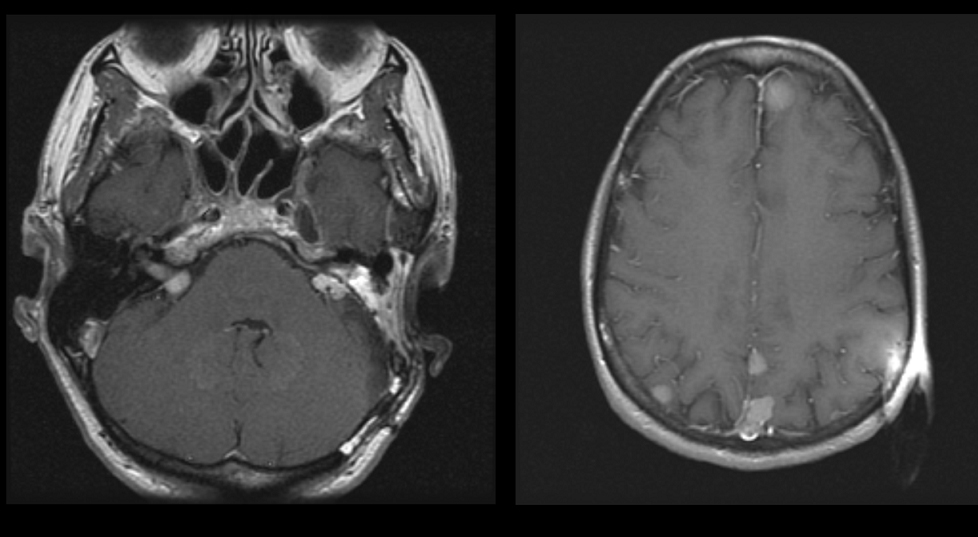WBR0107: Difference between revisions
Jump to navigation
Jump to search
No edit summary |
No edit summary |
||
| Line 21: | Line 21: | ||
|SubCategory=Neurology | |SubCategory=Neurology | ||
|Prompt=An eight-year-old boy is brought to the pediatrician by his mother after he complained that he could no longer hear his teacher. The patient denies pain, but his mother reports he seems to have decreased balance and complains of a ringing in his ears. MRI of the head reveal bilateral temporal opacities. What is the mode of inheritance of the most likely causal condition? | |Prompt=An eight-year-old boy is brought to the pediatrician by his mother after he complained that he could no longer hear his teacher. The patient denies pain, but his mother reports he seems to have decreased balance and complains of a ringing in his ears. MRI of the head reveal bilateral temporal opacities. What is the mode of inheritance of the most likely causal condition? | ||
|Explanation=The patient in this vignette has [[Neurofibromatosis Type II]]. The main manifestation of NF II is the development of bilateral, symmetric, non-malignant brain tumors in the region of the cranial nerve VIII. Theses tumors are called [[vestibular schwannomas]] (acoustic neuromas). NF II is also known as (or "MISME Syndrome", for "Multiple Inherited [[Schwannoma]]s, [[Meningioma]]s, and [[Ependymoma]]s") due to the predilection for these other brain tumors to form in patients. An example of a patient with bilateral acoustic neuromas (left panel) and meningiomas (right panel) is shown below. | |Explanation=The patient in this vignette has [[Neurofibromatosis Type II]]. The main manifestation of NF II is the development of bilateral, symmetric, non-malignant brain tumors in the region of the cranial nerve VIII. Theses tumors are called [[vestibular schwannomas]] (acoustic neuromas). Because they grow in the region of CN VIII, patients may develop hearing difficulties, tinnitus and balance disturbances. NF II is also known as (or "MISME Syndrome", for "Multiple Inherited [[Schwannoma]]s, [[Meningioma]]s, and [[Ependymoma]]s") due to the predilection for these other brain tumors to form in patients. An example of a patient with bilateral acoustic neuromas (left panel) and meningiomas (right panel) is shown below. | ||
More than 90% of NF II patients suffer eye lesions. The most common alteration in NF II is the juvenile subcapsular cataract (opacity of the lens) in young people. NF II is caused by mutations of the NF2 gene coding for the "Merlin" protein. "Merlin" localizes to adherens junctions, but its tumor suppressive properties remain poorly understood. The principal treatments consist of neurosurgical removal of the tumors and surgical treatment of the eye lesions. | More than 90% of NF II patients suffer eye lesions. The most common alteration in NF II is the juvenile subcapsular cataract (opacity of the lens) in young people. NF II is caused by mutations of the NF2 gene coding for the "Merlin" protein. "Merlin" localizes to adherens junctions, but its tumor suppressive properties remain poorly understood. The principal treatments consist of neurosurgical removal of the tumors and surgical treatment of the eye lesions. | ||
Revision as of 23:46, 25 March 2014
| Author | PageAuthor::William J Gibson |
|---|---|
| Exam Type | ExamType::USMLE Step 1 |
| Main Category | MainCategory::Genetics |
| Sub Category | SubCategory::Neurology |
| Prompt | [[Prompt::An eight-year-old boy is brought to the pediatrician by his mother after he complained that he could no longer hear his teacher. The patient denies pain, but his mother reports he seems to have decreased balance and complains of a ringing in his ears. MRI of the head reveal bilateral temporal opacities. What is the mode of inheritance of the most likely causal condition?]] |
| Answer A | AnswerA::Autosomal recessive |
| Answer A Explanation | [[AnswerAExp::Neurofibromatosis type 2 is autosomal dominant. An example of an autosomal recessive disease is Severe Combined Immunodeficiency.]] |
| Answer B | AnswerB::Autosomal dominant |
| Answer B Explanation | AnswerBExp::Neurofibromatosis type 2 is an autosomal dominant disease. |
| Answer C | AnswerC::X-linked recessive |
| Answer C Explanation | [[AnswerCExp::Neurofibromatosis type 2 is autosomal dominant. An example of an X-linked recessive disease is Duchenne muscular dystrophy.]] |
| Answer D | AnswerD::X-linked dominant |
| Answer D Explanation | [[AnswerDExp::Neurofibromatosis type 2 is autosomal dominant. An example of an X-linked recessive disease is Rett syndrome.]] |
| Answer E | AnswerE::Mitochondrial |
| Answer E Explanation | [[AnswerEExp::Neurofibromatosis type 2 is autosomal dominant. An example of an X-linked recessive disease is Myoclonic Epilepsy with Ragged Red Fibers.]] |
| Right Answer | RightAnswer::B |
| Explanation | [[Explanation::The patient in this vignette has Neurofibromatosis Type II. The main manifestation of NF II is the development of bilateral, symmetric, non-malignant brain tumors in the region of the cranial nerve VIII. Theses tumors are called vestibular schwannomas (acoustic neuromas). Because they grow in the region of CN VIII, patients may develop hearing difficulties, tinnitus and balance disturbances. NF II is also known as (or "MISME Syndrome", for "Multiple Inherited Schwannomas, Meningiomas, and Ependymomas") due to the predilection for these other brain tumors to form in patients. An example of a patient with bilateral acoustic neuromas (left panel) and meningiomas (right panel) is shown below.
More than 90% of NF II patients suffer eye lesions. The most common alteration in NF II is the juvenile subcapsular cataract (opacity of the lens) in young people. NF II is caused by mutations of the NF2 gene coding for the "Merlin" protein. "Merlin" localizes to adherens junctions, but its tumor suppressive properties remain poorly understood. The principal treatments consist of neurosurgical removal of the tumors and surgical treatment of the eye lesions.
|
| Approved | Approved::Yes |
| Keyword | WBRKeyword::Cancer, WBRKeyword::Genetics, WBRKeyword::Tumor suppressor gene, WBRKeyword::Tumor suppressor, WBRKeyword::Inheritance, WBRKeyword::Autosomal dominant, WBRKeyword::Oncology |
| Linked Question | Linked:: |
| Order in Linked Questions | LinkedOrder:: |
